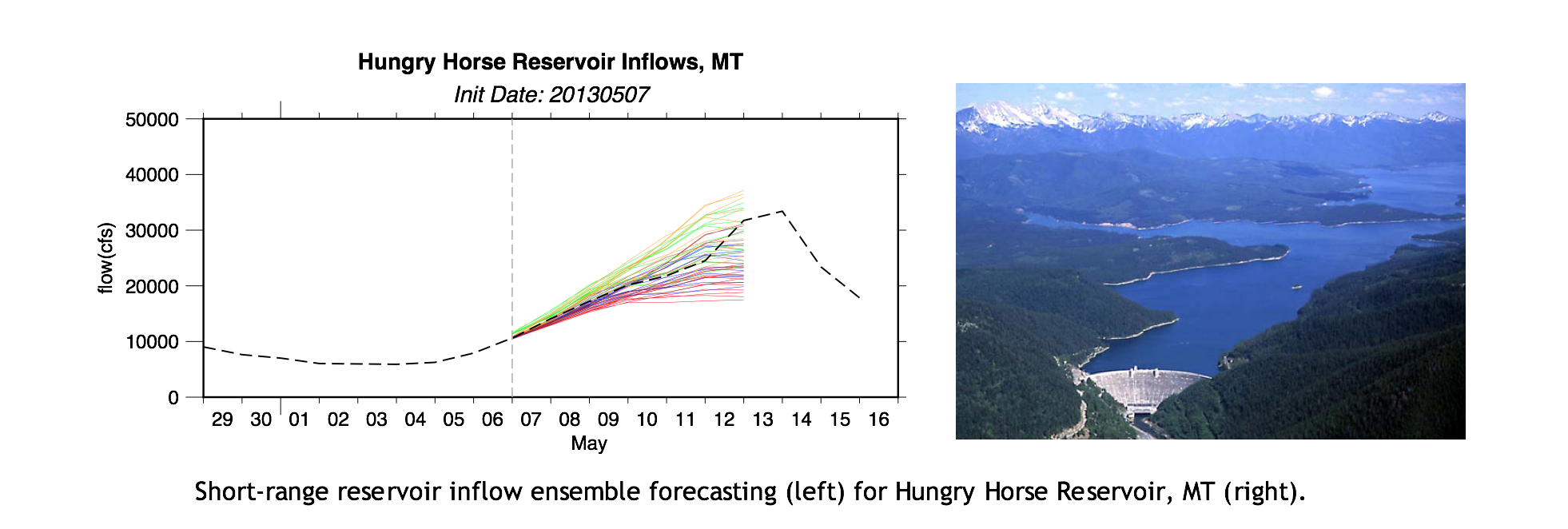Current operational hydrologic forecasting relies on legacy conceptual watershed models coupled with expert forecaster judgment – a medley of scripted processes and manual adjustments to data, analyses, and products made by trained hydrologists. While this approach benefits from the rich experience of hydrologists, the manual effort and ad hoc workflows limit the capacity to test the potential of new scientific approaches. Because the current practice is not reproducible, it cannot quantify forecast uncertainties, which decisionmakers increasingly require to balance risks and opportunities during challenging hydrometeorological events.
Scientists and engineers in RAL’s Hydrometeorological Applications Program at the National Center for Atmospheric Research have been sponsored by the U.S. Army Corps of Engineers and Bureau of Reclamation to evaluate whether new science-based techniques and strategies for real-time hydrologic flood and drought forecasting are now viable for supporting real-time water decisions. To answer this question, NCAR has collaborated with the University of Washington to develop and run a fully automated real-time forecast system called SHARP (System for Hydromet Analysis, Research, and Prediction). The system produces real-time ensemble streamflow predictions for lead times of days to seasons, using state-of-the-science weather and climate forecast datasets, hydrologic models, statistical methods and other tools. Overall, the approach enhances the physical realism of real-time watershed monitoring and prediction, while maintaining the computational agility needed to depict uncertainties (e.g., using ensemble techniques). The research will help us understand the tradeoffs of making components of our nation’s hydrologic monitoring and prediction workflows more automated and objective, opening the door to advances such as more complex watershed models and uncertainty aware products. The overarching goal is to strengthen our nation’s scientific foundation for operational hydrologic prediction to better manage resources and risk in the face of changing weather and climate extremes.
Assembles the building blocks for monitoring and prediction within an experimental real-time operational platform serving a selection of watersheds across the United States. Elements include higher complexity hydrologic modeling, statistical post-processing, hydrologic data assimilation, and ensemble techniques for hydrometeorological monitoring, weather and climate downscaling, and verification.
Facilitates a systematic intercomparison of monitoring and prediction techniques, enabling a structured way to assess whether a new technique improves watershed analyses and increases predictability relative to current approaches. For example, seasonal reservoir inflow predictions can be generated using a range of techniques (statistical, dynamical, and hybrid methods) that leverage predictability from both the land surface and climate, or by using simple versus complex hydrological models.
Evaluates the practicality of new science through interaction with reservoir managers to foster two-way learning that helps both researchers and streamflow prediction and water management communities identify opportunities to integrate advanced methods into prediction services and increase water management flexibility in the future.
Enables a real-world assessment of the suitability of more modern, complex watershed models for water management applications. Provides an analytical test bed comprising hundreds of calibrated watershed models across the United States for understanding hydrometeorological trends and variability.
Expand SHARP implementation to: contrast a broader variety of watershed models in a real-time context; demonstrate and evaluate the applicability of the new models; and demonstrate medium-range to seasonal ensemble prediction approaches.
The real-time forecast demonstration will raise awareness and promote discussion about alternative approaches within the research, operational and management communities.


NCAR: Andy Wood (PI), Martyn Clark (Co-PI), Pablo Mendoza, Andy Newman, Ethan Gutmann
University of Washington: Bart Nijssen, Elizabeth Clark
U.S. Army Corps of Engineers: Jeff Arnold
Bureau of Reclamation: Levi Brekke
Contact: Andy Wood - andywood@ucar.edu | Julie Vano - jvano@ucar.edu
Bureau of Reclamation, U.S. Army Corps of Engineers, and the National Oceanic and Atmospheric Administration
Model information:
Factsheets:
2-Pager (same info as this page)
Papers:
Datasets: